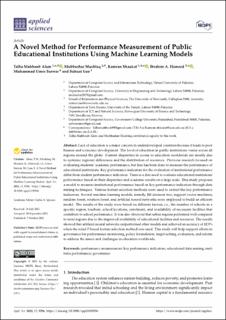| dc.description.abstract | Lack of education is a major concern in underdeveloped countries because it leads to poor human and economic development. The level of education in public institutions varies across all regions around the globe. Current disparities in access to education worldwide are mostly due to systemic regional differences and the distribution of resources. Previous research focused on evaluating students’ academic performance, but less has been done to measure the performance of educational institutions. Key performance indicators for the evaluation of institutional performance differ from student performance indicators. There is a dire need to evaluate educational institutions’ performance based on their disparities and academic results on a large scale. This study proposes a model to measure institutional performance based on key performance indicators through data mining techniques. Various feature selection methods were used to extract the key performance indicators. Several machine learning models, namely, J48 decision tree, support vector machines, random forest, rotation forest, and artificial neural networks were employed to build an efficient model. The results of the study were based on different factors, i.e., the number of schools in a specific region, teachers, school locations, enrolment, and availability of necessary facilities that contribute to school performance. It was also observed that urban regions performed well compared to rural regions due to the improved availability of educational facilities and resources. The results showed that artificial neural networks outperformed other models and achieved an accuracy of 82.9% when the relief-F based feature selection method was used. This study will help support efforts in governance for performance monitoring, policy formulation, target-setting, evaluation, and reform to address the issues and challenges in education worldwide | en_US |

